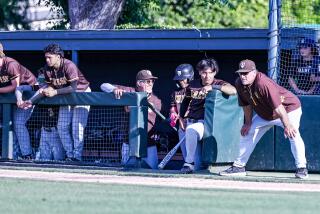San Fernando Mission Reflects Heritage
- Share via
During Pope John Paul II’s visit to Los Angeles, one of his stops was the Mission San Fernando Rey de Espana in Mission Hills. This is the 17th mission built in the chain established by the Franciscan Order in the 1700s, and one of the vestiges of Spanish culture in California.
Walking through the quiet gardens of the mission, one can enjoy solitude interrupted only by the ripple of water in a fountain. But it is easy to imagine a more active time when the occupants were brown-robed friars and leather-jacketed soldiers who served the Spanish Crown.
Surrounding the mission was a community of Indians whose labor would make San Fernando one of the most prosperous of the California chain.
The story of this mission begins in 1769. The Spanish government had long neglected the reports of Juan Rodriguez Cabrillo, who had discovered California in 1542, and Sebastian Vizcaino, who had charted its coast in 1602.
Russian Encroachment
And during that time, there emerged a potential threat to Spanish holdings along the Pacific Coast: the Russians crossed the Bering Sea and were developing a thriving fur industry in Alaska. In searching for otters, their ships had penetrated as far south as the Oregon coast.
It was Jose de Galvez who had been sent from Spain to Mexico in 1761 as inspector general, and prompted by the threat of English and Russian encroachment, had urged that Spain take immediate steps to block any foreign move by colonizing the land first.
He made plans for an expedition that would extend to Monterey, which had been charted earlier by Vizcaino. Galvez would have the help of a man who was destined to become one of the most famed figures in California history, Father Junipero Serra, who had been named president of California’s missions.
The first of three ships left La Paz in Lower California on Jan. 9, 1769. Don Gaspar de Portola would head a land party, while Serra would remain in San Diego to found the first mission in Alta California.
Father Juan Crespi accompanied the overland expedition, and while camped in the hills overlooking present-day Encino (which he named), the padre wrote Serra that he had discovered another fine location for a settlement. The project was later discussed, but due to various problems that arose, it was temporarily pigeonholed.
But in 1795, the mission president, Father Fermin Francisco de Lasuen, who had succeeded Serra, sent another exploring party from Mission San Buenaventura to find the right location for an intermediate mission between San Gabriel and the city known today as Ventura. This party concurred with Crespi’s findings, and on Sept. 8, 1797, the 17th of the missions in California was dedicated by Lasuen to Fernando III, the King of Spain. That afternoon he solemnly baptized 10 Indian children.
Much Agriculture
By 1819, one of its most prosperous years, the mission boasted almost 13,000 cattle and many horses, mules, sheep, goats and pigs. Its Indian converts became proficient craftsmen, fashioning objects in wood, stone, bone and shell.
The community also produced olive oil, tallow, soap, hides, shoes and clothing. Delicate ironwork was created over the forges of its blacksmith shop. There were abundant harvests of wheat, barley, corn, peas, lentils and garbanzos from its fields. Weary travelers praised the quality of the wine that was pressed from grapes grown in extensive vineyards.
The decline of the mission began in 1821, when Mexico declared its independence from Spain. The succession of governors who arrived in California were hostile to the Franciscan Order. Secularization in 1834--an idealistic policy promulgated in Mexico, which would restore the mission lands to uneducated Indians, resulted in unbridled graft and corruption perpetrated by government officials charged with enforcing the policy.
Gov. Pio Pico parceled off the mission’s property among his friends. Cattle no longer roamed the verdant pastures. The soil remained unturned in the fields and the vineyards were abandoned.
Americans arrived in force at the mission in 1847. This was the battalion recruited by John Charles Fremont to aid Commodore Robert Field Stockton and Gen. Stephen Watts Kearny in the conquest of California. Fremont’s column marched up to the mission gate shortly before he and Gen. Andres Pico signed the peace treaty that ended hostilities.
Property Restored
After the American occupation, the bishop of Monterey petitioned the U.S. government in 1853 for the return of church property. On May 31, 1862, President Abraham Lincoln signed a proclamation granting the church about 66 acres in the San Fernando Valley. By then, however, the mission was no longer prosperous, and by 1896, it was in ruins, with much of the land being used as a hog ranch.
Serious reconstruction financed by public donations began in 1938. On Sept. 7, 1941, a rededication ceremony was attended by 4,000 people.
The 1971 Sylmar earthquake nearly demolished the mission, but it was meticulously restored. Today, its eaves, piers and buttresses, arched corridors, sloping clay-tiled roofs and shaded walkways tell of an era when the flag of Spain flew over the presidios and pueblos of California.
The mission, now operated by the Catholic archdiocese, is at 15151 San Fernando Blvd., Mission Hills. Hours are 9 a.m. to 5 p.m. daily. Admission is $1.
More to Read
Sign up for Essential California
The most important California stories and recommendations in your inbox every morning.
You may occasionally receive promotional content from the Los Angeles Times.












